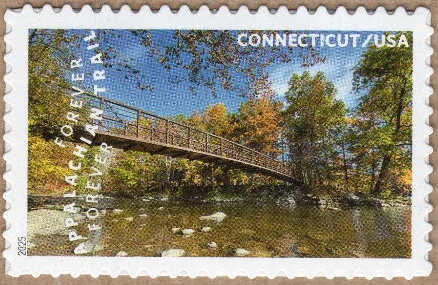Stamp: The Appalachian Trail in Connecticut (United States of America 2025)
The Appalachian Trail in Connecticut (United States of America 2025)
28 February (United States of America ) within release The Appalachian Trail (2025) goes into circulation Stamp The Appalachian Trail in Connecticut face value FOREVER No Face Value
| Stamp The Appalachian Trail in Connecticut in catalogues | |
|---|---|
| Colnect codes: | Col: US 2025.02.28-01m |
Stamp is horizontal format.
Stamp from mini sheet. Face value US$0.73 on day of issue.Also in the issue The Appalachian Trail (2025):
- Mini Sheet - The Appalachian Trail face value 15*FOREVER;
- Stamp - The Appalachian Trail face value FOREVER;
- Stamp - The Appalachian Trail in Connecticut face value FOREVER;
- Stamp - The Appalachian Trail in Georgia face value FOREVER;
- Stamp - The Appalachian Trail in Maine face value FOREVER;
- Stamp - The Appalachian Trail in Maryland face value FOREVER;
- Stamp - The Appalachian Trail in Massachusetts face value FOREVER;
- Stamp - The Appalachian Trail in New Hampshire face value FOREVER;
- Stamp - The Appalachian Trail in New Jersey face value FOREVER;
- Stamp - The Appalachian Trail in New York face value FOREVER;
- Stamp - The Appalachian Trail in North Carolina face value FOREVER;
- Stamp - The Appalachian Trail in Pennsylvania face value FOREVER;
- Stamp - The Appalachian Trail in Tennessee face value FOREVER;
- Stamp - The Appalachian Trail in Vermont face value FOREVER;
- Stamp - The Appalachian Trail in Virginia face value FOREVER;
- Stamp - The Appalachian Trail in West Virginia face value FOREVER;
Stamp The Appalachian Trail in Connecticut it reflects the thematic directions:
A bridge is a structure built to span physical obstacles without closing the way underneath such as a body of water, valley, or road, for the purpose of providing passage over the obstacle. There are many different designs that each serve a particular purpose and apply to different situations. Designs of bridges vary depending on the function of the bridge, the nature of the terrain where the bridge is constructed and anchored, the material used to make it, and the funds available to build it.
A landscape is the visible features of an area of land, its landforms and how they integrate with natural or man-made features. A landscape includes the physical elements of geophysically defined landforms such as (ice-capped) mountains, hills, water bodies such as rivers, lakes, ponds and the sea, living elements of land cover including indigenous vegetation, human elements including different forms of land use, buildings and structures, and transitory elements such as lighting and weather conditions. Combining both their physical origins and the cultural overlay of human presence, often created over millennia, landscapes reflect a living synthesis of people and place that is vital to local and national identity. The character of a landscape helps define the self-image of the people who inhabit it and a sense of place that differentiates one region from other regions. It is the dynamic backdrop to people’s lives. Landscape can be as varied as farmland, a landscape park, or wilderness. The earth has a vast range of landscapes, including the icy landscapes of polar regions, mountainous landscapes, vast arid desert landscapes, islands and coastal landscapes, densely forested or wooded landscapes including past boreal forests and tropical rainforests, and agricultural landscapes of temperate and tropical regions.
A river is a natural freshwater stream that flows on land or inside caves towards another body of water at a lower elevation, such as an ocean, lake, or another river. A river may run dry before reaching the end of its course if it runs out of water, or only flow during certain seasons. Rivers are regulated by the water cycle, the processes by which water moves around the Earth. Water first enters rivers through precipitation, whether from rainfall, the runoff of water down a slope, the melting of glaciers or snow, or seepage from aquifers beneath the surface of the Earth.
Tourism is travel for pleasure or business; also the theory and practice of touring, the business of attracting, accommodating, and entertaining tourists, and the business of operating tours. Tourism may be international, or within the traveller's country. The World Tourism Organization defines tourism more generally, in terms which go "beyond the common perception of tourism as being limited to holiday activity only", as people "traveling to and staying in places outside their usual environment for not more than one consecutive year for leisure, business and other purposes". Tourism can be domestic or international, and international tourism has both incoming and outgoing implications on a country's balance of payments. Today, tourism is a major source of income for many countries, and affects the economy of both the source and host countries, in some cases being of vital importance.




